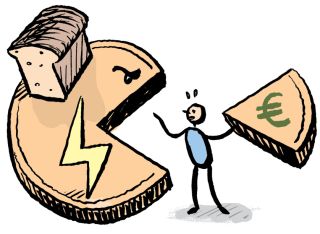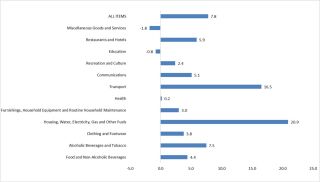Winners and Losers - Latest Inflation Data shows Deep Disparities

The latest inflation indices published by the CSO make stark reading. The Consumer Price Index (CPI) rose by 7.8 per cent in the year to May 2022, while the EU Harmonised Index of Consumer Prices (HICP) increased by 8.3 per cent in the same period. While Energy prices continue to drive inflation, due to no small part to the impact of the Russian invasion of Ukraine, a look behind the headline data shows that there is plenty that properly-targeted Government policy could address.
Main Drivers
The largest increase came in the sub-index for Housing, Water, Electricity, Gas and Other Fuels rose by 20.9 per cent in the year to May 2022; followed by Transport, which increased by 16.5 per cent; and Alcoholic Beverages and Tobacco, which rose by 7.5 per cent (Chart 1), however there are large differences even within sub-indices.
Chart 1: Consumer Price COICOP Division Indices, to the year May 2022

Source: CSO, 2022: Consumer Price Index May 2022, www.cso.ie
If we take a deeper look at the sub-index with the highest rate of inflation in the year to May 2022, that of Housing, Water, Electricity, Gas and Other Fuels (+20.9 per cent) (Table 1), we see that while actual rents and mortgage interest increased by 8.5 per cent in the year to May 2022, this is largely driven by Private Rents (+11.2 per cent), rather than mortgage interest (+4.1 per cent). While Maintenance and Repair of the Dwelling increased by 7.2 per cent, this is mainly due to inflation in the costs of materials (+13.5 per cent) rather than maintenance and repair services (+3.1 per cent).
Increases in the costs of energy is driving overall inflation, with Electricity, Gas and Other Fuels increasing by 56.7 per cent, however, again, the impact of electricity increases (+40.9 per cent) is less than natural gas (+61 per cent) or Home Heating Oil (+102.5 per cent).
Table 1: COICOP Division 04 Housing, Water, Electricity, Gas and Other Fuels, May 2022
| Description | % Change | ||
| Actual rentals for housing & mortgage interest | 8.5 | ||
| Actual rentals for housing paid by tenants (Rents) | 10.0 | ||
| Private rents | 11.2 | ||
| Local Authority rents | 3.2 | ||
| Mortgage Interest | 4.1 | ||
| Maintenance and Repair of the Dwelling | 7.2 | ||
| Materials for the maintenance and repair of the dwelling | 13.5 | ||
| Services for the maintenance and repair of the dwelling | 3.1 | ||
| Water supply & miscellaneous services relating to the dwelling | 3.0 | ||
| Electricity, gas & Other Fuels | 56.7 | ||
| Electricity | 40.9 | ||
| Gas | |||
| Natural Gas | 61.0 | ||
| Bottled Gas | 8.4 | ||
| Liquid fuels (Home Heating Oil) | 102.5 | ||
| Solid Fuels | 25.9 | ||
| Total | 20.9 | ||
Source: CSO, 2022: Consumer Price Index May 2022, www.cso.ie
While increases in fuel costs driven by the Russian invasion of Ukraine are largely outside of Irish Governmental control, there are measures that could be taken to lessen the impact of increases in this division. Introducing supply-side measures to increase rent affordability for private tenancies, as outlined in our Housing Costs and Poverty 2022 policy briefing; fixing the model of procurement of building materials, as outlined in Chapter 6 of our socioeconomic review Social Justice Matters: a 2022 guide to a fairer Irish society; and supporting low-income households to reduce their reliance on fossil-fuel heating to cheaper alternatives, as proposed in our Budget Choices briefings over several years, could cushion the impact of inflation on middle- and low-income households.
Taking the division with the next-highest rate of inflation, Transport (+16.5 per cent) (Table 2), again we see a range of sectoral impacts and measures that Government could take to protect families. While the cost of purchasing a motor car has increased by 13.2 per cent, and the cost of Diesel and Petrol have increased by 41.6 per cent and 25.9 per cent respectively, fares on public transport have decreased. The cost of passenger transport by railway has decreased by 20.6 per cent, and the cost of bus fares has decreased by 20.8 per cent.
Table 2: COICOP Division 7 Transport, May 2022
| Description | % Change | ||
| Purchase of vehicles | 12.9 | ||
| Motor cars | 13.2 | ||
| Motor cycles | 3.0 | ||
| Bicycles | 2.1 | ||
| Operation of personal transport equipment | 24.2 | ||
| Spare parts & accessories for personal transport equipment | 8.1 | ||
| Fuels & lubricants for personal transport equipment | 33.4 | ||
| Petrol | 25.9 | ||
| Diesel | 41.6 | ||
| Motor Oil | 4.7 | ||
| Maintenance & repair of personal transport equipment | 2.6 | ||
| Other services in respect of personal transport equipment | 18.6 | ||
| Motor Tax | 0.0 | ||
| Other vehicle costs | 33.2 | ||
| Transport services | 8.1 | ||
| Passenger transport by railway | -20.6 | ||
| Passenger transport by road | -14.8 | ||
| Bus fares | -20.8 | ||
| Taxi fares | 0.0 | ||
| Passenger transport by air | 45.4 | ||
| Passenger transport by sea & inland waterway | 11.8 | ||
| Combined passenger transport | -21.0 | ||
| Other purchased transport services | 3.0 | ||
| Total | 16.5 | ||
Source: CSO, 2022: Consumer Price Index May 2022, www.cso.ie
Here, too, there are measures that Government could choose to make that would greatly alleviate the financial burden on households. Expanding the public transport fleet and routes, particularly in rural areas, would reduce the reliance on motor transport, thereby reducing the impact of both increases in the cost of purchasing a car and fuel to run it. The cost of air transport has increased by 45.4 per cent, yet Government consistently refuses to tax jet kerosene. These increases are, therefore, predominantly increases in the profit margins of airlines. Imposing a tax on jet kerosene (and including commercial and corporate air transport vehicles within this tax net) would not only further the Government's Green Agenda, but would also raise much-needed revenue to invest in a Just Transition.
The third highest division is that of Alcohol and Tobacco products, which increased by 7.5 per cent overall. The highest rate of increase was in alcohol, specifically beer, which increased by 12.7 per cent, followed by spirits (+11.6 per cent), and wine (+3.8 per cent). Cigarettes and other tobacco products increased by 6.6 per cent and 7.5 per cent respectively (Table 3).
Table 3: COICOP Division 2 Alcohol and Tobacco Products, May 2022
| Description | % Change | ||
| Alcoholic Beverages | 7.8 | ||
| Spirits | 11.6 | ||
| Wine | 3.8 | ||
| Beer | 12.7 | ||
| Tobacco | 6.7 | ||
| Cigarettes | 6.6 | ||
| Other tobacco products | 7.5 | ||
| Total | 7.5 |
Source: CSO, 2022: Consumer Price Index May 2022, www.cso.ie
In January of this year, the Government introduced minimum unit pricing on alcohol, which set a minimum price for a gram of alcohol, meaning that it cannot be sold for less than the price set. The minimum price is set at 10c per gram of alcohol. A standard alcoholic drink contains 10 grams of alcohol, meaning a minimum price of €1. This is not a tax that creates revenue for the Exchequer. 100 per cent of the increase goes to the alcohol industry.
The measure was introduced as a means of combatting excessive alcohol consumption, with the HSE website citing the introduction of a minimum unit price on alcohol in Scotland as a success. However the final report of Public Health Scotland from its evaluation of the impact of minimum unit pricing in Scotland, published in June 2022, concluded "The introduction of a £0.50 MUP in Scotland led to a marked increase in the prices paid for alcohol by people with alcohol dependence. There is no clear evidence that this led to reduced alcohol consumption or levels of alcohol dependence among people drinking at harmful levels. There is some evidence it increased financial strain among economically vulnerable groups but no clear evidence that it caused wider negative consequences, such as increased criminality, illicit substance use or acute withdrawal.".
So, there's no benefit to the Exchequer and no benefit to the health of those with harmful alcohol dependency. There is some evidence that it caused "increased financial strain". Low-income households where there is a harmful alcohol dependence present cannot absorb this increased financial strain in addition to cost of living increases. Government should invest more in independent alcohol awareness training and supports for addiction, rather than imposing a policy that increases profits for the alcohol industry.
But what about divisions which saw costs declining in the year to May 2022? Areas such as Education, which saw an overall decrease of 0.8 per cent; and Miscellaneous Goods & Services, which decreased by 1.8 per cent? As may, by now, be expected, there are differences within these divisions also.
In Education, both primary and secondary school costs increased (by 0.7 per cent and 2.8 per cent respectively), while costs of tertiary education decreased by 0.6 per cent and 'Education not definable by level' decreased by 10 per cent. Obviously, decreases in tertiary education are overtaken by increases in the cost of rents for students studying away from the family home, and increases in costs in the younger age groups puts pressure on families, particularly lone parents who experience high levels of poverty.
As for Miscellaneous Goods & Services, while travel insurance (+7.8 per cent) and hairdressing (+3.6 per cent) have increased, luxury good such as jewellery, clocks and watches (-12.6 per cent) have decreased significantly. Interestingly, also within this division is motor car insurance which decreased by 10.9 per cent (however the cost of buying the car and providing diesel would cancel much of that out).
Conclusion
The cost of living is likely to continue to increase over the course of the year. While drivers such as energy costs due to the Russian invasion of Ukraine are outside of the control of the Irish Government, there are plenty of measures that Government could choose to implement that would greatly relieve the burden on households, particularly those on low incomes.
Following the Government's announcements on cost of living measures earlier this year, Social Justice Ireland proposed two practical measures to Government to reduce the cost of living for low income households; benchmarking core social welfare rates to 27.5 per cent of average weekly earnings and making the two main tax credits refundable. These policies would directly assist people on fixed incomes and people in low paid employment who are most impacted by the rising cost of living. In our response to the package of measures to deal with the cost of living announced by Government on 10th February, we noted that the bulk of the funding available (€378m) went on a universal energy credit, rather than on measures to target low income and rural households who have been most impacted by increasing energy prices. A more appropriate use of the €378m allocated to the universal energy credit would have been to implement the OECD recommendation to redesign the fuel allowance, delink it from heating fuels, update and expand the eligibility criteria and provide it to eligible households during the whole year. This would provide a tool for Government to target and support rural and low income households (those impacted most by inflation) now and in the years ahead as policies to meet the targets set out in the carbon budgets are implemented.